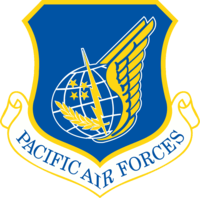345th Airlift Squadron
345th Airlift Squadron
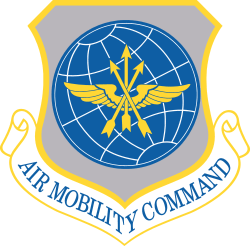 | |
|---|---|
|
C-130J taking off from Keesler Air Force Base, Mississippi | |
| Country |
|
| Branch |
|
| Role | Airlift |
| Part of | Air Mobility Command |
| Garrison/HQ | Keesler Air Force Base, Mississippi |
| Nickname(s) | Golden Eagles |
| Motto(s) | Accedere Totaliter Latin Complete Compliance in All Things |
| Engagements | Gulf War |
| Decorations |
Air Force Outstanding Unit Award w/Combat "V" Device Air Force Outstanding Unit Award Philippine Republic Presidential Unit Citation Vietnamese Gallantry Cross with Palm |
| Insignia | |
| 345th Airlift Squadron emblem (approved 24 May 1957)[1] |
|
The 345th Airlift Squadron is an inactive United States Air Force squadron most recently assigned to the 19th Operations Group at Keesler Air Force Base, Mississippi, where it was inactivated in June 2014.
The squadron was first activated as the 345th Troop Carrier Squadron in the Air Force Reserve in 1949 and trained at Memphis Municipal Airport, Tennessee. In 1951 it was called to active duty for the Korean War and served until 1953.
In 1955 the unit was activated at Sewart Air Force Base, Tennessee as a rotary wing troop carrier assault unit in a test of the USAF's ability to support United States Army assault operations. It participated in Operation Sage Brush, which was, in part, a test of this concept. The squadron was inactivated the following year and its aircraft distributed to helicopter support organizations.
A few months later the squadron was activated as a fixed wing troop carrier assault unit at Sewart and equipped with Fairchild C-123 Provider aircraft. It continued to fly the Provider until 1961 when it converted the Lockheed C-130 Hercules. It has continued to fly various models of the Hercules ever since.
In 1962 the squadron was moved to the Pacific area and came under the control of the 315th Air Division, which managed airlift resources for Pacific Air Forces. The squadron returned on paper to the United States a few months later and its personnel and equipment were transferred to another squadron.
The 345th returned to the Pacific in 1965 and began to deploy C-130s to Southeast Asia, and in 1966 moved from Okinawa to Ching Chuan Kang Air Base, where it was assigned to the 314th Troop Carrier Wing. Following the end of the Viet Nam War, the squadron returned to Okinawa and served in the Pacific until it was inactivated in 1993.
The squadron was most recently activated in the summer of 2010 as an "active duty associate" squadron, jointly operating the C-130J aircraft of the 815th Airlift Squadron.
Mission
The mission of the 345th Airlift Squadron is to provide combat support to commanders through theater combat delivery of personnel and resupply worldwide. To perform its mission, the squadron conducts airland, aeromedical evacuation and tactical airdrop low level missions.[2]
History
Reserve training and Korean War callup
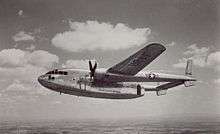
The squadron was activated in the reserves in 1949 and assigned to the 516th Troop Carrier Group.[1] The squadron trained under the supervision of the 2584th Air Force Reserve Training Center at Memphis Municipal Airport, Tennessee until April 1951. The 345th was called to active duty that month and participated in tactical exercises and worldwide airlift. It converted from Curtiss C-46 Commando to Fairchild C-119 Flying Boxcar aircraft in 1952.[3] The 345th was replaced by the 772d Troop Carrier Squadron in January 1953.[4]
Helicopter assault operations
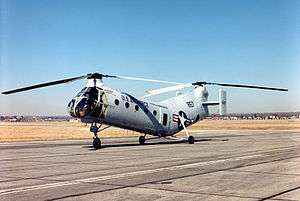
The squadron was reactivated in 1955 and assigned to the 516th Troop Carrier Group at Sewart Air Force Base, Tennessee as the 345th Troop Carrier Squadron, Assault, Rotary Wing in part to test the United States Air Force's ability to provide helicopter airlift to the Army. The 345th was initially equipped with Sikorsky H-19 helicopters, but soon replaced them with Piasecki H-21s.[5] Its operations included participation in Operation Backlash II, which was a survey mission to fix the location of radar sites and support the construction of the Mid-Canada Line.[5][6] The group also tested the evacuation of key high ranking personnel from Washington DC in the event of a nuclear attack.[5] The squadron collected radiological samples at the Nevada Test Site during atomic tests.[1]
The conflict between the Army and the Air Force concerning the use of Air Force helicopters to support Army assault operations was tested in Operation Sage Brush. The 345th operated as part of the 20th Combat Airlift Division (Provisional) supporting Army Group Gulf, the aggressor force. The squadron's H-21s were dismantled and transported in Douglas C-124 Globemaster II aircraft in a test of air mobility.[6] Following this test, the 345th was inactivated in July 1956. The helicopters of the squadron were transferred to the 20th Helicopter Squadron, whose mission was support for routine Air Force activities.[7]
Fixed wing airlift in the United States
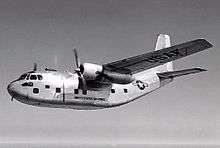
Three months later, the squadron was reactivated at Sewart as a Fairchild C-123 Provider unit.[8][9] The squadron trained to airlift troops, equipment and supplies into combat zones, to resupply forces, and evacuate casualties. In 1958, most of the C-123s at Sewart were transferred to Pope Air Force Base, North Carolina and the squadron's parent 513th Troop Carrier Wing was inactivated.[10] However, the unit continued to fly Providers at Sewart until 1961, when it converted to the Lockheed C-130 Hercules[1] by exchanging crews and aircraft with the 62d Troop Carrier Squadron. which temportrily took over the 345th's Providers.[11]
In the spring of 1962 the squadron moved to the Pacific and Naha Air Base, Okinawa, where it was assigned to the 315th Air Division.[1] Its first stay in the Pacific was brief, however, and on 8 January 1963 its mission, personnel and aircraft were transferred to the newly activated 35th Troop Carrier Squadron,[12][13] while the 345th returned on paper to Dyess Air Force Base, Texas, where it was reunited with the 516th Troop Carrier Wing.[1] While at Dyess the squadron participated in humanitarian airlift to New Orleans following a hurricane.[14]
Viet Nam war
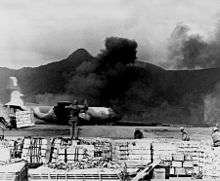
As the United States Air Force (USAF) built up its forces in the Pacific as the Viet Nam War grew larger, however, the squadron returned to Naha in 1965. Four months later, it moved closer to the conflict at Ching Chuan Kang Air Base, Republic of China[1] (usually called "CCK"). Although the squadron itself was not stationed in Viet Nam, it flew C-130s to augment task forces and other operational organizations during Vietnam War until 1973.[1]
In 1968, a member of the squadron, Lt. Col. Howard Dallman, was awarded the Air Force Cross for his heroism at Khe Sanh. Col Dallman was deployed to Tuy Hoa Air Base along with C-130s from the squadron. On 5 February he was on a mission to transport a load of ammunition and a medical evacuation team to Khe Sanh. The weather was forecast to be at the minimum for an instrument approach, which made landing at the mountain-girded strip a challenge. The challenge was increased when the crew discovered that Khe Sanh's ground-controlled approach radar was out of commission. The crew's navigator. Maj. Gerald Johnson, was confident he could make a successful airborne radar approach, and the plane broke out of the overcast at three hundred feet above the airstrip. As the C-130 came to a stop, it was hit by a shell that ignited ammunition boxes in the cargo compartment. The crew immediately began fighting the fire while Dallman began backing up the plane to an area at the far end of the runway, where if the ammunition exploded it would not destroy the runway and support facilities nearby. The crew, with help from the Khe Sanh fire truck extinguished the fire and helped offload the ammo boxes.[15]
As the last pallet of ammunition was unloaded, one of the plane's tires was blown by a sniper's bullet, and a mortar attack bracketed the C-130. The plane, which was drawing most of the fire, was towed for a short distance, then taxied to a maintenance area. There the damaged wheel was changed while the plane remained under fire from mortars, rockets, artillery, and heavy machine guns. While the wheel was being changed, Dallman agreed to fly an out-of-commission bulldozer back to Da Nang Air Base. As the aircraft positioned for takeoff, one engine, which had ingested debris from an exploding mortar round, quit. The 20,000-pound bulldozer had to be unloaded. Dallman left the plane to get permission to attempt a three-engine takeoff, but the crew managed to get the fourth engine started. The plane was hit again as it took off, but without serious damage. Dallman and his crew saved a valuable transport plane, delivered a load of ammunition to the surrounded Marines, and prevented major damage to a battered outpost. For dealing heroically with a series of crises that day, Dallman was awarded the Air Force Cross, the first tactical airlift crewman to be so honored.[15]
In May 1971, the USAF withdrew its tactical units from Naha Air Base. As a result, the 374th Tactical Airlift Wing moved to CCK, assuming the place of the 314th wing (which returned to the US) and becoming the 345th squadron's headquarters).[16][17][18] As C-123 and DeHavilland Canada C-7A Caribou aircraft were transferred to the Vietnam Air Force, the 374th wing became responsible for all C-130 airlift in Viet Nam.[19] In late 1973, with the termination of USAF involvement in Viet Nam, all tactical units were withdrawn from CCK and the squadron returned to Okinawa at Kadena Air Base.[1]
Pacific airlift
Following the end of hostilities in Southeast Asia, the squadron provided tactical, aeromedical, and operational support to Department of Defense agencies throughout the Pacific region from Kadena, and later from Yokota Air Base, until 1993.[1] In December 1990 the squadron deployed to participate in Operation Desert Shield.[20] It provided crews to the 1661st Tactical Airlift Squadron (Provisional) in Oman and the 1676th Tactical Airlift Squadron (Provisional) at King Fahd Airport, Saudi Arabia.[21]
Active duty associate unit
The squadron was redesignated the 345th Airlift Squadron and activated in August 2010 at Keesler Air Force Base, Mississippi. At Keesler, it is an "active duty associate" unit. It is assigned no aircraft of its own, but its crews fly the C-130J aircraft of the 815th Airlift Squadron of Air Force Reserve Command. Although the squadron is assigned to the 19th Operations Group at Little Rock Air Force Base, it is under the operational control of the 403d Wing at Keesler.[2]
The squadron performed its first deployment in January 2011 to Afghanistan. Together with members of the 815th and the 41st Airlift Squadron, they formed the 772d Expeditionary Airlift Squadron at Kandahar Airfield. Through airdrops of supplies to expeditionary forces in Afghanistan the deployed squadron members were able to avoid the need to dispatch convoys through dangerous areas to supply remote units.[2] The squadron deployed again from 9 May to 16 September 2012.[22]
Under the Force Structure Action Implementation Plan, the 345th and 815th squadrons were programmed to move to Pope Air Force Base, North Carolina on 1 October 2013. In August the Air Force announced that the move was being delayed until at least April 2014.[23] The squadron was inactivated in June, although most active duty members were transferred to other units in April, resulting in the unit inactivation ceremony being held in late April.[24]
Lineage
- Constituted as the 345th Troop Carrier Squadron, Medium on 10 May 1949
- Activated in the reserve on 26 June 1949
- Ordered to active service on 16 April 1951
- Inactivated on 16 January 1953
- Redesignated 345th Troop Carrier Squadron, Assault, Rotary Wing on 8 December 1954
- Activated on 8 March 1955
- Inactivated on 9 July 1956
- Redesignated 345th Troop Carrier Squadron, Assault, Fixed Wing on 27 July 1956
- Activated on 8 October 1956
- Redesignated as 345th Troop Carrier Squadron, Assault on 1 July 1958
- Redesignated as 345th Troop Carrier Squadron, Medium on 18 December 1961
- Redesignated as 345th Troop Carrier Squadron on 8 December 1965
- Redesignated as 345th Tactical Airlift Squadron on 1 August 1967
- Redesignated as 345th Airlift Squadron on 1 April 1992
- Inactivated on 1 July 1993
- Redesignated as 345th Expeditionary Airlift Flight and converted to provisional status on 29 September 2004
- Withdrawn from provisional status on 9 September 2009
- Redesignated as 345th Airlift Squadron on 7 July 2010
Assignments
- 516th Troop Carrier Group, 26 June 1949 – 16 January 1953
- 516th Troop Carrier Group, 8 March 1955 – 9 July 1956
- Eighteenth Air Force, 8 October 1956 (attached to 513th Troop Carrier Group)
- Ninth Air Force, 1 September 1957 (attached to 513th Troop Carrier Group)
- 839th Air Division, 8 October 1957 (attached to 513th Troop Carrier Wing until 12 November 1958, 314th Troop Carrier Wing, until c. 15 May 1962)
- 315th Air Division, 1 June 1962
- 516th Troop Carrier Wing, 8 January 1963
- 315th Air Division, 27 November 1966 (attached to 6315th Operations Group)
- 314th Troop Carrier Wing (later 314th Tactical Airlift Wing), 25 March 1966;
- 374th Tactical Airlift Wing, 31 May 1971
- 316th Tactical Airlift Group, 1 October 1978
- 374th Tactical Airlift Wing, 1 October 1989
- 374th Operations Group, 1 April 1992 – 1 July 1993
- Air Mobility Command to activate or inactivate at any time on or after 29 September 2009
- 19th Operations Group, 6 Aug 2010 – June 2014[25][24]
Stations
- Memphis Municipal Airport, Tennessee, 26 June 1949 – 16 January 1953
- Sewart Air Force Base, Tennessee, 8 March 1955 – 9 July 1956
- Sewart Air Force Base, Tennessee, 8 October 1956 – 15 May 1962
- Naha Air Base, Okinawa, Japan, 2 June 1962
- Dyess Air Force Base, Texas, 8 January 1963
- Naha Air Base, Okinawa, 27 November 1965
- Ching Chuan Kang Air Base, Taiwan, 20 March 1966
- Kadena Air Base, Okinawa, Japan, 1 December 1973
- Yokota Air Base, Japan, 1 September 1975 – 1 July 1993
- Keesler Air Force Base, Mississippi, 6 August 2010 – June 2014[25][24]
Commanders
- Unknown 26 Jun 1949 – 17 Apr 1951
- Maj Fred H. Towne Jr., 17 Apr 1951
- Lt Col Benjamin F. Kelly, 8 Sep 1952-1953
- Maj James F. Fowler, 1955
- Maj Gregg D. Hartley, 19 May-9 Jun 1956
- Maj James F. Fowler, 1956
- Lt Col Perry H. Penn, 19 Feb 1957
- Lt Col Robert J. Marks, 21 Jan 1960
- Lt Col Joseph H. Griffith Jr., 20 Oct 1961-unknown
- Lt Col Richard D. Cote, unknown-8 Jan 1963
- Lt Col Raymond E. Carleton, 8 Jan 1963
- Lt Col William M. Cossaboom, 1 Apr 1964
- Lt Col Angelo N. Castanza, 31 Jan 1965
- Lt Col John H. Hazel, 30 Jun 1965
- Lt Col Leland A. Younkin, 5 Nov 1965
- Lt Col Robert J. Craig, 16 Oct 1966
- Lt Col John A. Zimmerman, 3 Jul 1967
- Lt Col Edward T. Davis, 1 May 1968
- Lt Col Loren A. Stoddard, 1 Jul 1968 - unknown
- Lt Col Thomas J. Leonard, by 30 Sep 1970-unknown
- Lt Col William F. Ellis, by 31 May 1971
- Lt Col Philip J. Riede, 4 Feb 1972
- Lt Col James S. Kinney, 31 Jan 1974
- Lt Col Harold W. Reed, 6 Jun 1975
- Col Charles A. Vickery, 21 Jan 1977
- Lt Col Roland L. Tharp, 1 Mar 1978
- Lt Col Sherman W. Bear, 28 Jun 1979
- Lt Col Frederick N. Buckingham, 17 Nov 1980
- Lt Col Daniel E. Sowada, 23 Jul 1982
- Lt Col Gregory G. Kirkland, 29 Jun 1984
- Lt Col John W. Brooks, 27 Jun 1986
- Lt Col Terry H. Messer, 6 Jul 1988
- Lt Col Edward J. McClure Jr., 12 Jan 1990
- Lt Col Edward J. Feeney Jr., 1 Apr 1992 - unknown
- Lt Col Craig L. Williams, 6 Aug 2010 - unknown[25]
Aircraft
- Curtiss C-46 Commando, 1949–1952
- Fairchild C-119 Flying Boxcar, 1952–1953
- Sikorsky H-19, 1955
- Piasecki H-21 Workhorse ("Flying Banana"), 1955-1956
- Fairchild C-123 Provider, 1956-1961
- Lockheed C-130 Hercules, 1961-1963, 1963-1965, 1965-1993, 2010–2014[25][24]
Awards and campaigns
| Award streamer | Award | Dates | Notes |
|---|---|---|---|
| Air Force Outstanding Unit Award w/Combat "V" Device | 1 November 1967-31 December 1969 | 345th Tactical Airlift Squadron[1] | |
| Air Force Outstanding Unit Award w/Combat "V" Device | 12 February 1975-17 May 1975 | 345th Tactical Airlift Squadron[1] | |
| Air Force Outstanding Unit Award | 1 January 1964-9 December 1965 | 345th Troop Carrier Squadron[1] | |
| Air Force Outstanding Unit Award | 1 January 1982-31 December 1983 | 345th Tactical Airlift Squadron[1] | |
| Air Force Outstanding Unit Award | 1 January 1984-30 June 1985 | 345th Tactical Airlift Squadron[1] | |
| Air Force Outstanding Unit Award | 1 July 1987-30 June 1989 | 345th Tactical Airlift Squadron[1] | |
| Philippine Republic Presidential Unit Citation | 21 July 1972-15 August 1972 | 345th Tactical Airlift Squadron[1] | |
| Vietnamese Gallantry Cross with Palm | 1 November 1967-31 December 1969 | 345th Tactical Airlift Squadron[1] |
| Campaign Streamer | Campaign | Dates | Notes |
|---|---|---|---|
| Defense of Saudi Arabia | 9 December 1990 – 16 January 1991 | 345th Tactical Airlift Squadron[1] | |
| Liberation and Defense of Kuwait | 17 January 1991 – 11 April 1991 | 345th Tactical Airlift Squadron[1] |
References
Notes
- 1 2 3 4 5 6 7 8 9 10 11 12 13 14 15 16 17 18 19 20 Robertson, Patsy (8 December 2010). "Factsheet 345 Airlift Squadron (AMC)". Air Force Historical Research Agency. Retrieved 15 January 2014.
- 1 2 3 "Factsheet 345th Airlift Squadron "The Golden Eagles"". 403rd Wing. 27 July 2011. Archived from the original on 13 July 2015. Retrieved 15 January 2014.
- ↑ "Abstract, History 516 Troop Carrier Wing Jul-Dec 1952". Air Force History Index. Retrieved 11 January 2014.
- ↑ "Abstract, History 463 Troop Carrier Wing Jan-Jun 1953". Air Force History Index. Retrieved 11 January 2014.
- 1 2 3 "Abstract, Initial History 516 Troop Carrier Group". Air Force History Index. Retrieved 11 January 2014.
- 1 2 "Abstract, History 314 Troop Carrier Wing Jul-Dec 1955". Air Force History Index. Retrieved 11 January 2014.
- ↑ "Abstract, Vol. 1, History 314 Troop Carrier Wing Jan-Jun 1956". Air Force History Index. Retrieved 11 January 2014. The full designation of the 20th was "20th Helicopter Squadron (Support)"
- ↑ "Abstract, Vol. 1, History 314 Troop Carrier Wing Jul-Dec 1956". Air Force History Index. Retrieved 11 January 2014.
- ↑ See Maurer, Maurer, ed. (1983) [1961]. Air Force Combat Units of World War II (PDF) (reprint ed.). Washington, DC: Office of Air Force History. pp. 338–339. ISBN 0-912799-02-1. LCCN 61060979.
- ↑ "Abstract, History 513 Troop Carrier Wing Jul-Dec 1961". Air Force History Index. Retrieved 16 January 2014.
- ↑ "Abstract, History 314 Troop Carrier Wing Jul-Dec 1961". Air Force History Index. Retrieved 16 January 2014.
- ↑ Maurer, Maurer, ed. (1982) [1969]. Combat Squadrons of the Air Force, World War II (PDF) (reprint ed.). Washington, DC: Office of Air Force History. pp. 170–171. ISBN 0-405-12194-6. LCCN 70605402. OCLC 72556.
- ↑ "Abstract, History 345 Troop Carrier Squadron Jul-Dec 1962". Air Force History Index. Retrieved 16 January 2014.
- ↑ "Abstract, Vol. 1, History 516 Troop Carrier Wing Jul-Dec 1965". Air Force History Index. Retrieved 16 January 2014.
- 1 2 Frisbee, John L. (July 1989). "Valor:Airlift to Khe Sanh". Air Force Magazine. Retrieved 15 January 2014.
- ↑ Ravenstein, Charles A. (1984). Air Force Combat Wings, Lineage & Honors Histories 1947-1977 (PDF). Washington, DC: Office of Air Force History. pp. 196–198. ISBN 0-912799-12-9.
- ↑ Ravenstein, p. 162
- ↑ see Ravenstein, p. 84
- ↑ "Abstract, Vol. 1 History 834 Air Division Jul-Nov 1971". Air Force History Index. Retrieved 16 January 2014.
- ↑ "Abstract, Vol. 1 History 834 Airlift Division 1990". Air Force History Index. Retrieved 16 January 2014.
- ↑ Broeking, Timothy D. "Abstract, Vol. 50 Operation Desert Storm Documents". Center for Aerospace Doctrine, Research and Education. Retrieved 16 January 2014.
- ↑ "Keesler airlift squadron deploys for the second time this year". Associated Press. 16 September 2012. Archived from the original on 16 January 2014. Retrieved 15 January 2014.
- ↑ "Air Force delays plans to shift planes from Keesler". Mississippi Business Journal from the Associated Press. 14 August 2013. Retrieved 15 January 2014.
- 1 2 3 4 5 Losurdo, Maj Marlee S. C. (23 April 2014). "403rd Wing says farewell to 345th Airlift Squadron during informal ceremony". Air Force History Index. Retrieved 8 July 2015.
- 1 2 3 4 5 Lineage, including assignments, stations, commanders and aircraft in Robertson, AFHRA Factsheet
Bibliography
- Maurer, Maurer, ed. (1982) [1969]. Combat Squadrons of the Air Force, World War II (PDF) (reprint ed.). Washington, DC: Office of Air Force History. ISBN 0-405-12194-6. LCCN 70605402. OCLC 72556.
- Ravenstein, Charles A. (1984). Air Force Combat Wings, Lineage & Honors Histories 1947-1977 (PDF). Washington, DC: Office of Air Force History. ISBN 0-912799-12-9.
- AF Pamphlet 900-2, Unit Decorations, Awards and Campaign Participation Credits Department of the Air Force, Washington, DC, 15 Jun 1971
Further reading
- Cantwell, Gerald T. (1997). Citizen Airmen: a History of the Air Force Reserve, 1946-1994 (PDF). Washington, D.C.: Air Force History and Museums Program. ISBN 0-16049-269-6. Retrieved 1 October 2014.
- Nalty, Bernard C. (1986). Air Power and the Fight for Khe Sanh (PDF). Washington, DC: Office of Air Force History. ISBN 978-1410222589. Retrieved 7 July 2015.
- Vaughan, David K. (1998). Runway Visions: An American C-130 Pilot's Memoir of Combat Airlift Operations in Southeast Asia 1967-1968. Jefferson, NC: McFarland & Company. ISBN 0-7864-0488-4. (Capt Vaughan was a pilot with the 345th Tactical Airlift Squadron)
External links
- Dunn, Harry. "History of the 23rd Helicopter Squadron". Retrieved 11 January 2014.
- "Classic Rotors". Retrieved 11 January 2014.
- "C-130 Dyess timeline". Abeline Reporter News. 23 April 2011. Retrieved 29 January 2014.
- "Fact Sheet: 345th Airlift Squadron "The Golden Eagles"". 403rd Wing Public Affairs. July 27, 2011. Archived from the original on October 30, 2012. Retrieved August 29, 2016.



